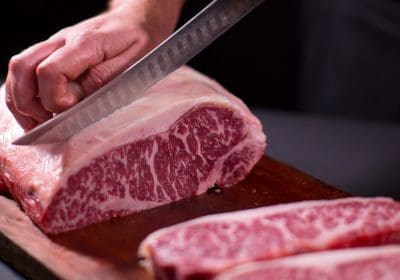PUT two samples of highly-marbled Wagyu beef on a table at room temperature, and it’s not uncommon to see the fat in one sample remain firmer, while the other starts to ‘melt.’
It’s an expression of the naturally-occurring variation in fatty acid profiles that can be produced by otherwise similar Wagyu animals, even if they are fed and managed under the same conditions.
 Wagyu breeders could soon start selecting cattle for specific desirable fatty acid profiles in beef, rather than simply taking a broad-brush approach in selection for ‘marbling’, stakeholders attending the recent Australian Wagyu Association’s 2022 annual conference in Melbourne heard.
Wagyu breeders could soon start selecting cattle for specific desirable fatty acid profiles in beef, rather than simply taking a broad-brush approach in selection for ‘marbling’, stakeholders attending the recent Australian Wagyu Association’s 2022 annual conference in Melbourne heard.
AWA’s chief executive Matt McDonagh said tests using Near Infra-Red measurement technology were already in use in Japan for assessing Wagyu fat composition.
“We are already talking with a Japanese developer about using NIRS technology to measure carcases in Australia, particularly for the desirable mono-unsaturated fatty acid content, which is very important for Wagyu fat,” Dr McDonagh told Beef Central.
Such technologies had already been examined in Australia, but not specifically for Wagyu, and certainly not extensively.
“We will be using the test extensively in our Wagyu progeny test program,” Dr McDonagh said.
Assessment of the technology will start shortly, with implement on genetic selection likely to start soon after that.
Dr McDonagh said there was plenty of evidence to show that there was wide variation in fatty acid composition between Wagyu animals.
“We see evidence of it every year in the Wagyu branded beef competition. When we pull the 40-odd entries out of the coldroom and present them for judging, as raw steaks, some start to ‘melt’ immediately at room temperature, and others not so much. That’s difference in fatty acid composition – between what can be two otherwise identical Fullblood Wagyu carcases,” he said.
“The encouraging point is that we know from Japanese research that the trait (desirable mono-unsaturated fatty acid ratio) is high heritable – it has a higher than 0.5 heritability (1.0 being completely heritable from one generation to another).
“It means breeders can make significant genetic progress by selecting for desirable fatty acids, based on progeny test results.”
Given that there were now tools to use to select for desirable fatty acid profiles, and a clear consumer preference for beef with higher mono-unsaturated fat, it would become a trait that would come into cattle selection calculations in years to come, Dr McDonagh said.
“It’s definitely a path the Australian Wagyu industry is going forward with. It’s a key trait that will indicate that fineness of marbling and ultimate eating quality, that really defines high quality Wagyu,” he said.
Dr McDonagh said the Australian Wagyu industry would be able to start measuring fatty acid components within the next 12 months, based on some preliminary data. “It’s just a matter of how quickly we can gather enough data to get started.”
He said the end-point was likely to be the development of a BreedPlan EBV for desirable fatty acids within Wagyu cattle.
Currently the Wagyu breed has EBVs for marbling score (abundance), and marbling fineness (fine marbling texture is desirable over coarse).
The next step would be the establishment of a marbling quality EBV, measuring the ratio of desirable mono-unsaturated fat compared with saturated fat, which is typically seen as fat ‘softness.’ The higher the mon-unsaturates, the softer the fat, which melts more quickly on the palate, delivering the customary Wagyu ‘flavour’ explosion.
Understanding the flavour chemistry of Wagyu beef
Also speaking during this year’s conference was flavour chemist Professor Heather Smythe, a principal research fellow with QAAFI, University of Queensland, who gave a presentation at the conference on the flavour chemistry of Wagyu beef.

Prof Heather Smythe
Dr Smythe was the architect behind the development of AA Co’s Wagyu flavour wheel, covered in this earlier Beef Central article.
Beef Central asked Dr Smythe how sophisticated Wagyu fat composition assessment was likely to get over time, and whether Wagyu cattle breeders were likely to be motivated to select animals for specific flavour and fatty acid performance.
“I absolutely think this is likely to continue to evolve, over time,” she said.
“We are just starting to get into the language and understanding of the sensory properties of Wagyu, and what that diversity looks like,” she said.
“What we really need to do next is invest in some capability to be able to measure these specific flavour volatiles objectively,” she said. “This way, we can apply this kind of thinking across all of the different studies we are doing, and understand what the impact is of a certain Wagyu genetic line, or what the impact is of a certain diet.”
“This would allow us to connect some of this information across the board in Australia, to know what the types of flavours that we are dealing with in Wagyu are, and if we have a good handle on that, then we can make business decisions about a certain diet or genetic type to enhance the flavours that we want in the product.”
“That’s exactly what winegrowers do. They make decisions on which yeast to use, knowing that a cool climate chardonnay, for example, will release certain types of volatiles, when exposed to this yeast.”
The value of provenance
During her presentation, Prof Smythe said part of the provenance of any food product told a story about the product, and the history of where it came from.
“It’s almost a romantic marketing tale about that product that conveys to the consumer, a sense of value. Ideally, that value should be translated into recognisable characteristics that are present in that product,” she said.
Lots of different industries and brands used provenance to help convey the distinctiveness and value of their products to consumers, she said.
“Provenance in food implies and verifies food origin, safety, sensory qualities, a point of difference and a premium value and price-point,” she said.
“When used in branding, provenance can help add value to a product, and is used extensively in high-value foods like coffee, wine – and ought to be used in something like Wagyu,” she said.
“It’s an Australian brand position that can’t easily be copied by competitors.”
She said the provenance story needed to be tied to specific and recognisable consumer qualities, and that any point-of-difference in sensory qualities needed to be understood and well-communicated.
“That’s why things like flavour wheels become important,” she said.
Just as regional flavour was important in wine, ‘brand’ flavour could become important in Wagyu beef.
Beef’s complex makeup
Prof Smythe said a food product like beef was comprised mostly of water, fat and protein. The part that the human olafactory system was most involved with was the volatile aroma compounds, making up less than one percent of a sample of beef.
“Across all of the different types of beef that there is, we know that there are as many as 880 volatile aroma compounds involved, mainly involved in the aroma sensation that we experience in beef. These very enormously in terms of chemical class and potency.”
“As a flavour chemist, what’s interesting is that the complexity of beef is equal to that of wine. Some of the most complex foods are cocoa and coffee, while wine and beef rank next on the list.
“So beef is really quite incredibly complex, and the range of beef that producers attending even this Wagyu conference are producing is really quite enormous. This is a landscape that is really not well understood, unlike wine or other products,” Prof Smythe said.
With beef, particularly, the cooking step was particularly important, because heat liberated a lot of the important flavour compounds that are in the sample. If those precursors were not present, it was not possible to create those flavours upon cooking.
Prof Smythe said the main influences on the flavour of meat were genetics and the animal’s diet, but other contributors included the age, gender and condition of the animal; the seasonality prior to slaughter, the cut; how the animal was handled before, during and after slaughter; processing, packaging and aging. All of those things added unique flavour pre-cursors contributing to the unique signature that that piece of beef was going to have.
“All those factors are creating this wealth of volatile aroma pre-cursors ready to be liberated upon cooking. They are really the signatures of the brand or the way that particular group of animals has been treated, throughout their life.”
Dr Smythe said having worked with the Australian Agricultural Co in the development of the company’s Wagyu flavour wheel, and similar work with other Wagyu beef companies, there definitely was a brand point of distinction evident when comparing beef from different production systems.
“One of the great benefits from such work is having a baseline understanding of what the quality parameters are in their beef. When they are trying new diets or applying new management regimes, they actually have a standard to compare with, allowing them to ask, Have we changed the flavour, or have we impacted the great quality of our product?”
“It’s a great tool to act as a baseline – but we need to flesh that out in much more detail.”
Earlier, Dr Simone Rochfort, research leader for molecular phenomics with Latrobe University’s School of Applied Systems Biology, told the conference that particular molecular traits had been identified that were associated with Wagyu meat tenderness, flavour, mouthfeel, colour retention and other characteristics.
“What we can do is align those molecular signatures in genomic programs to work out, for example, which genes are responsible for production of these particular molecules, and then incorporate that data into genetic selection programs to elevate desirable characteristics.”
“But this is a small sample for genetic study. We need many, many more samples to validate some of this preliminary work,” she said.



HAVE YOUR SAY